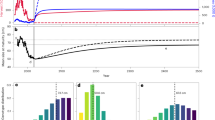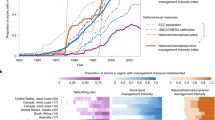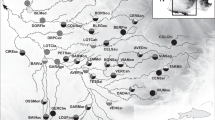Abstract
One of the most pervasive themes in ecology is that biological diversity stabilizes ecosystem processes and the services they provide to society1,2,3,4, a concept that has become a common argument for biodiversity conservation5. Species-rich communities are thought to produce more temporally stable ecosystem services because of the complementary or independent dynamics among species that perform similar ecosystem functions6. Such variance dampening within communities is referred to as a portfolio effect7 and is analogous to the effects of asset diversity on the stability of financial portfolios8. In ecology, these arguments have focused on the effects of species diversity on ecosystem stability but have not considered the importance of biologically relevant diversity within individual species9. Current rates of population extirpation are probably at least three orders of magnitude higher than species extinction rates10, so there is a pressing need to clarify how population and life history diversity affect the performance of individual species in providing important ecosystem services. Here we use five decades of data from Oncorhynchus nerka (sockeye salmon) in Bristol Bay, Alaska, to provide the first quantification of portfolio effects that derive from population and life history diversity in an important and heavily exploited species. Variability in annual Bristol Bay salmon returns is 2.2 times lower than it would be if the system consisted of a single homogenous population rather than the several hundred discrete populations it currently consists of. Furthermore, if it were a single homogeneous population, such increased variability would lead to ten times more frequent fisheries closures. Portfolio effects are also evident in watershed food webs, where they stabilize and extend predator access to salmon resources. Our results demonstrate the critical importance of maintaining population diversity for stabilizing ecosystem services and securing the economies and livelihoods that depend on them. The reliability of ecosystem services will erode faster than indicated by species loss alone.
This is a preview of subscription content, access via your institution
Access options
Subscribe to this journal
Receive 51 print issues and online access
$199.00 per year
only $3.90 per issue
Buy this article
- Purchase on Springer Link
- Instant access to full article PDF
Prices may be subject to local taxes which are calculated during checkout



Similar content being viewed by others
References
MacArthur, R. H. Fluctuations of animal populations, and a measure of community stability. Ecology 36, 533–536 (1955)
Elton, C. S. The Ecology of Invasions by Animals and Plants (Chapman & Hall, 1958)
Hooper, D. U. et al. Effects of biodiversity on ecosystem functioning: a consensus of current knowledge. Ecol. Monogr. 75, 3–35 (2005)
Chapin, F. S. et al. Consequences of changing biodiversity. Nature 405, 234–242 (2000)
Duffy, J. E. Why biodiversity is important to the functioning of real-world ecosystems. Front. Ecol. Environ 7, 437–444 (2009)
Tilman, D. Biodiversity: population versus ecosystem stability. Ecology 77, 350–363 (1996)
Figge, F. Bio-folio: applying portfolio theory to biodiversity. Biodivers. Conserv. 13, 827–849 (2004)
Markowitz, H. Portfolio selection. J. Finance 7, 77–91 (1952)
Luck, G. W., Daily, G. C. & Ehrlich, P. R. Population diversity and ecosystem services. Trends Ecol. Evol. 18, 331–336 (2003)
Hughes, J. B., Daily, G. C. & Ehrlich, P. R. Population diversity: its extent and extinction. Science 278, 689–692 (1997)
Hilborn, R., Quinn, T. P., Schindler, D. E. & Rogers, D. E. Biocomplexity and fisheries sustainability. Proc. Natl Acad. Sci. USA 100, 6564–6568 (2003)
Hutchinson, W. F. The dangers of ignoring stock complexity in fishery management: the case of the North Sea cod. Biol. Lett. 4, 693–695 (2008)
Quinn, T. P. The Behavior and Ecology of Pacific Salmon and Trout (Univ. Washington Press, 2005)
Doak, D. F. et al. The statistical inevitability of stability-diversity relationships in community ecology. Am. Nat. 151, 264–276 (1998)
Mantua, N. J. & Hare, S. R. The Pacific decadal oscillation. J. Oceanogr. 58, 35–44 (2002)
Schindler, D. E. et al. Climate change, ecosystem impacts, and management for Pacific salmon. Fisheries 33, 502–506 (2008)
Gende, S. M., Edwards, R. T., Willson, M. F. & Wipfli, M. S. Pacific salmon in aquatic and terrestrial ecosystems. Bioscience 52, 917–928 (2002)
Naiman, R. J., Bilby, R. E., Schindler, D. E. & Helfield, J. M. Pacific salmon, nutrients, and the dynamics of freshwater and riparian ecosystems. Ecosystems (NY, Print) 5, 399–417 (2002)
Schindler, D. E., Leavitt, P. R., Brock, C. S., Johnson, S. P. & Quay, P. D. Marine-derived nutrients, commercial fisheries, and production of salmon and lake algae in Alaska. Ecology 86, 3225–3231 (2005)
Helfield, J. M. & Naiman, R. J. Keystone interactions: salmon and bear in riparian forests of Alaska. Ecosystems (NY, Print) 9, 167–180 (2006)
Payne, L. X. & Moore, J. M. Mobile scavengers create hotspots of freshwater productivity. Oikos 115, 69–80 (2006)
Olsen, E. M. et al. Small-scale biocomplexity in coastal Atlantic cod supporting a Darwinian perspective on fisheries management. Evol. Appl. 1, 524–533 (2008)
Dixson, D. L. et al. Coral reef fish smell leaves to find island homes. Proc. R. Soc. Lond. B 275, 2831–2839 (2008)
Rooker, J. R. et al. Natal homing and connectivity in Atlantic bluefin tuna populations. Science 322, 742–744 (2008)
Gustafson, R. G. et al. Pacific salmon extinctions: quantifying lost and remaining diversity. Conserv. Biol. 21, 1009–1020 (2007)
Lindley, S. T. et al. What Caused the Sacramento River Fall Chinook Stock Collapse? Pre-publication report (Pacific Fishery Management Council, 2009); available at 〈http://swr.nmfs.noaa.gov/media/salmondeclinereport.pdf〉.
Moore, J. W., McClure, M., Rogers, L. A. & Schindler, D. E. Synchronization and portfolio performance of threatened salmon. Conserv. Lett. 10.1111/j.1755-263X.2010.00119.x. (in the press)
Folke, C. et al. Regime shifts, resilience, and biodiversity in ecosystem management. Annu. Rev. Ecol. Syst. 35, 557–581 (2004)
West, F. W. & Fair, L. F. Abundance, Age, Sex, and Size Statistics for Pacific Salmon in Bristol Bay, 2003. Fishery Data Series No. 06–47 (Alaska Department of Fish and Game, 2006)
Rogers, L. A. & Schindler, D. E. Asynchrony in population dynamics in sockeye salmon of southwest Alaska. Oikos 117, 1578–1586 (2008)
Pyper, B. J. & Peterman, R. M. Comparison of methods to account for autocorrelation in correlation analyses of fish data. Can. J. Fish. Aquat. Sci. 55, 2127–2140 (1998)
Acknowledgements
We thank the Gordon and Betty Moore Foundation, the US National Science Foundation, the University of Washington, the Alaska salmon processing industry and the H. Mason Keeler Professorship for support for this work. N. Baron, L. Neeley and S. Sethi provided feedback and comments on the manuscript, and P. Lisi and G. Holtgrieve helped prepare the figures.
Author information
Authors and Affiliations
Contributions
D.E.S. designed and coordinated the project; R.H., B.C. and L.A.R contributed to the analyses; M.S.W. helped design the project; and all authors contributed to the writing.
Corresponding author
Ethics declarations
Competing interests
The authors declare no competing financial interests.
Supplementary information
Supplementary Information
This file contains Supplementary Information comprising: Value of sockeye salmon resources in Bristol Bay and Variance scaling in data, Supplementary Figures 1-3 with legends and References. (PDF 273 kb)
Rights and permissions
About this article
Cite this article
Schindler, D., Hilborn, R., Chasco, B. et al. Population diversity and the portfolio effect in an exploited species. Nature 465, 609–612 (2010). https://doi.org/10.1038/nature09060
Received:
Accepted:
Issue Date:
DOI: https://doi.org/10.1038/nature09060
This article is cited by
-
Microsatellite Analysis of the Influence of Sebastes schlegelii Restocking on the Genetic Structure of Stocks in Rongcheng Bay
Thalassas: An International Journal of Marine Sciences (2024)
-
Genetic diversity within late-summer run and half-pounder steelhead (Oncorhynchus mykiss) in the Rogue River, Oregon
Conservation Genetics (2024)
-
Monitoring genome-wide diversity over contemporary time with new indicators applied to Arctic charr populations
Conservation Genetics (2024)
-
Current and historical patterns of recruitment of Yellowstone cutthroat trout in Yellowstone Lake, Wyoming, as revealed by otolith microchemistry
Hydrobiologia (2024)
-
Asynchrony in coral community structure contributes to reef-scale community stability
Scientific Reports (2023)
Comments
By submitting a comment you agree to abide by our Terms and Community Guidelines. If you find something abusive or that does not comply with our terms or guidelines please flag it as inappropriate.



